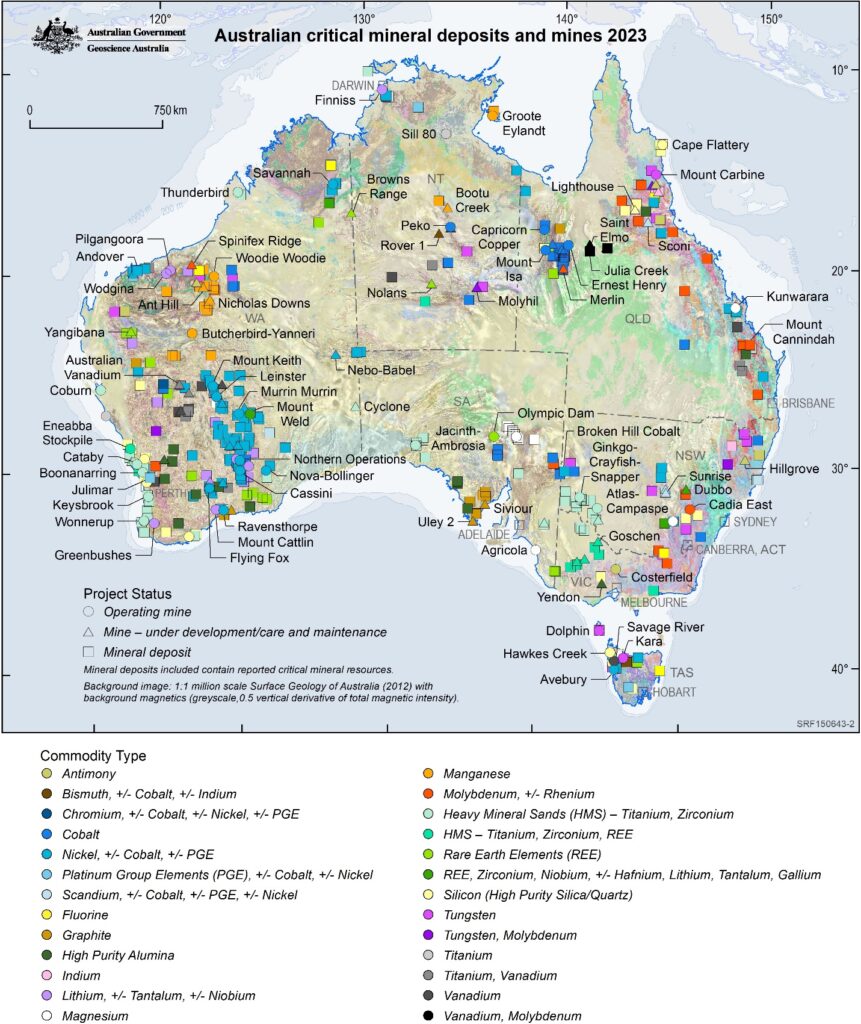Highlights
- Geoscience Australia supports Australia’s Critical Minerals Strategy 2023-2030 through research, data services, and international collaborations.
- Critical minerals are essential for modern technologies and economies, with 31 resource commodities considered critical by the Australian Government.
- Australia is a global leader in critical mineral production, including lithium, cobalt, manganese ore, and rare earths.
Geoscience Australia (opens in a new tab) is a statutory agency of the Government of Australia that carries out geoscientific research. The agency is the government’s technical adviser on aspects of geoscience and serves as the repository of geographic and geological data collated by the Commonwealth.
Geoscience Australia supports the objectives of Australia’s Critical Minerals Strategy 2023–2030 (opens in a new tab) to grow our critical minerals sector, expand downstream processing, and help meet future global demand. GeoscienceAustralia supports the Critical Minerals Office (opens in a new tab) to help grow Australia’s critical minerals sector and position Australia globally as a secure, reliable, and ethical supplier of critical minerals.
The agency’s critical minerals activities include:
- Technical advice to the government
- Scientific research, including pre-competitive data acquisition
- Data-enabling services and decision-support tools
- International and national collaborations
- Publications
- Public communication
- Investment attraction
These activities align with Geoscience Australia’s priority stream of Building Australia’s resource wealth under Strategy 2028 (opens in a new tab), in particular the Exploring for the Future (opens in a new tab) program, which aims to support the resources and agricultural sectors through the provision of pre-competitive data for potential mineral, energy, and groundwater resources, including critical minerals.
What is a critical mineral?
A critical mineral is a metallic or non-metallic element that has two characteristics:
- It is essential for the functioning of our modern technologies, economies, or national security, and
- There is a risk that its supply chains could be disrupted.
Critical minerals are used to manufacture advanced technologies, including mobile phones, computers, fiber-optic cables, semiconductors, banknotes, and defense, aerospace, and medical applications. Many are used in low-emission technologies, such as electric vehicles, wind turbines, solar panels, and rechargeable batteries. Some are also crucial for common products, such as stainless steel and electronics.
Risks to critical mineral supply chains can come about when mineral production or processing is dominated by individual countries or companies that could limit availability. Other risks include market immaturity, political decisions, social unrest, natural disasters, mine accidents, geological scarcity, pandemics, and war.
Overview of Critical Minerals
A critical mineral is a metallic or non-metallic element that is essential for modern technologies, economies, or national security and has a supply chain at risk of disruption. Individual countries develop their own lists of critical minerals based on the relative importance of particular minerals to their industrial needs and strategic assessment of supply risks. In addition, assessments of mineral criticality reflect market and political conditions at a particular point in time and are subject to change.
As of February 2024, the Australian Government considers 31 resource commodities to be critical minerals. These have been selected by assessing Australia’s geological endowment and potential with global technology needs, particularly those of partner countries such as the United States, European Union, India, Japan, South Korea and the United Kingdom. Australia’s 31 critical minerals are listed in the table below with more information here (opens in a new tab) or in J Burton, U.S. Geological Survey Releases 2022 List of Critical Minerals (opens in a new tab) , United States Geological Survey (USGS), U.S. Department of the Interior, Federal Government of the United States, 2022, accessed 6 December 2023.
See the link for complete table (opens in a new tab).
Australia’s critical minerals sector is constantly growing in response to the increasing global need for a secure supply of these vital and strategic minerals. Australia’s Identified Mineral Resources 2023 (opens in a new tab) shows that, in 2022, Australia retained its position as the world’s top lithium producer (52%) and was also a top five producer for cobalt (3%), manganese ore (10%), rare earths (5%), rutile (27%), tantalum (4%), and zircon (25%). As well as being a global leader in the supply of critical minerals, many more deposits have been discovered or are under development, as seen in the map below.

Follow the link to learn more about Australia’s critical mineral situation. (opens in a new tab)

Daniel
You Might Also Like…